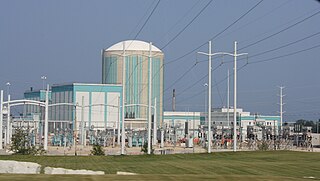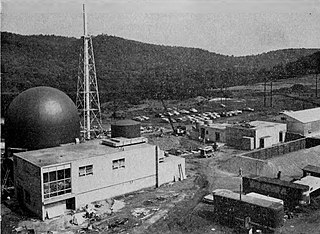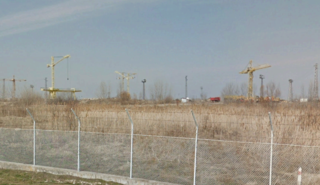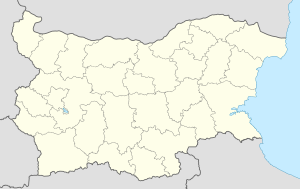
A nuclear power plant (NPP) is a thermal power station in which the heat source is a nuclear reactor. As is typical of thermal power stations, heat is used to generate steam that drives a steam turbine connected to a generator that produces electricity. As of September 2023, the International Atomic Energy Agency reported there were 410 nuclear power reactors in operation in 32 countries around the world, and 57 nuclear power reactors under construction.

Dry cask storage is a method of storing high-level radioactive waste, such as spent nuclear fuel that has already been cooled in the spent fuel pool for at least one year and often as much as ten years. Casks are typically steel cylinders that are either welded or bolted closed. The fuel rods inside are surrounded by inert gas. Ideally, the steel cylinder provides leak-tight containment of the spent fuel. Each cylinder is surrounded by additional steel, concrete, or other material to provide radiation shielding to workers and members of the public.

Belene is a town in Pleven Province, Northern Bulgaria. It is the administrative centre of the homonymous Belene Municipality. The town is situated on the right bank of the Danube river, close to the town of Svishtov.

Braidwood Generating Station is located in Will County in northeastern Illinois, U.S. The nuclear power plant serves Chicago and northern Illinois with electricity. The plant was originally built by Commonwealth Edison company, and subsequently transferred to Com Ed's parent company, Exelon Corporation. Following Exelon's spin-off of their Generation company, the station was transferred to Constellation Energy.

The Callaway Plant is a nuclear power plant located in Callaway County, Missouri. The plant is Missouri's only nuclear power plant and is close to Fulton, Missouri. The 2,767 acres (1,120 ha) site began operations on December 19, 1984. It generates electricity from one 1,190-megawatt Westinghouse four-loop pressurized water reactor and a General Electric turbine-generator. The Ameren Corporation owns and operates the plant through its subsidiary Ameren Missouri. It is one of several Westinghouse reactors designs called the "Standard Nuclear Unit Power Plant System," or SNUPPS.

The Sequoyah Nuclear Plant is a nuclear power plant located on 525 acres (212 ha) located 7 miles (11 km) east of Soddy-Daisy, Tennessee, and 20 miles (32 km) north of Chattanooga, abutting Chickamauga Lake, on the Tennessee River. The facility is owned and operated by the Tennessee Valley Authority (TVA).

The Prairie Island Nuclear Generating Plant is an electricity-generating facility located in Red Wing, Minnesota, along the Mississippi River, and adjacent to the Prairie Island Indian Community reservation.

The Virgil C. Summer Nuclear Power Station occupies a site near Jenkinsville, South Carolina, in Fairfield County, South Carolina, approximately 20 miles (32 km) northwest of Columbia.

The Kewaunee Power Station is a decommissioned nuclear power plant, located on a 900 acres (360 ha) plot in the town of Carlton, Wisconsin, 27 miles (43 km) southeast of Green Bay, Wisconsin in Kewaunee County, and south of the city of Kewaunee.

Point Beach Nuclear Plant is a nuclear power plant located on Lake Michigan in the town of Two Creeks, Wisconsin, United States. The plant was built by Wisconsin Electric Power Company, and previously operated by the Nuclear Management Company. The plant is currently owned and operated by NextEra Energy Resources, of Juno Beach, Florida.

The Kozloduy Nuclear Power Plant is a nuclear power plant in Bulgaria situated 180 kilometres (110 mi) north of Sofia and 5 kilometres (3.1 mi) east of Kozloduy, a town on the Danube river, near the border with Romania. It is the country's only nuclear power plant and the largest in the region. The construction of the first reactor began on 6 April 1970.

The Saxton Nuclear Experiment Station, also known as the Saxton Nuclear Generating Station or Saxton Nuclear Experimental Corporation Facility, was a small nuclear power plant located in Bedford County, near Saxton, Pennsylvania.
The Chashma Nuclear Power Plant is a large commercial nuclear power plant located at Chashma in Mianwali, Punjab, Pakistan.

The Belene Nuclear Power Plant is an abandoned nuclear power plant 3 km from Belene and 11 km from Svishtov in Pleven Province, northern Bulgaria, near the Danube River. It was intended to substitute four VVER-440 V230 reactors of the Kozloduy Nuclear Power Plant that were decommissioned as a prerequisite for Bulgaria to join the European Union.

Energy in Bulgaria is among the most important sectors of the national economy and encompasses energy and electricity production, consumption and transportation in Bulgaria. The national energy policy is implemented by the National Assembly and the Government of Bulgaria, conducted by the Ministry of Energy and regulated by the Energy and Water Regulatory Commission. The completely state-owned company Bulgarian Energy Holding owns subsidiaries operating in different energy sectors, including electricity: Kozloduy Nuclear Power Plant, Maritsa Iztok 2 Thermal Power Plant, NEK EAD and Elektroenergien sistemen operator (ESO); natural gas: Bulgargaz and Bulgartransgaz; coal mining: Maritsa Iztok Mines. In Bulgaria, energy prices for households are state-controlled, while commercial electricity prices are determined by the market.
Atomstroyexport is the Russian Federation's nuclear power equipment and service exporter. It is a fully owned subsidiary of Rosatom. The activities of Atomstroyexport are financially supported by the Russian government. The President of ASE Group of Companies is Alexander Lokshin.
Nuclear power in Romania provides around 20% of its electricity, with two nuclear reactors commencing operations in 1996 and 2007. In 2020, Romania generated a total of 56.1 TWh of electricity. The generation mix was composed of hydro (28%), nuclear (20%), natural gas (15%), coal (17%), wind (12%), solar (3%), and biofuels & waste. The Romanian government strongly supports nuclear energy.
National nuclear energy policy is a national policy concerning some or all aspects of nuclear energy, such as mining for nuclear fuel, extraction and processing of nuclear fuel from the ore, generating electricity by nuclear power, enriching and storing spent nuclear fuel and nuclear fuel reprocessing. Nuclear energy policies often include the regulation of energy use and standards relating to the nuclear fuel cycle.

In Hungary, nuclear energy plays a decisive role in the national energy mix, While in 2006, only 38 percent of the country's electricity came from nuclear fission, by 2014 that proportion had risen to over 53 percent. It is predicted that rate of around 50 percent will be permanent in the near future.

The electricity sector in Bulgaria is an important part of energy in Bulgaria and is highly diversified. As of 2021 nuclear power accounts for 34.7% of Bulgaria's power, coal power provides 39.4%, while renewable energy provides 15.8% of the country's electricity needs.














